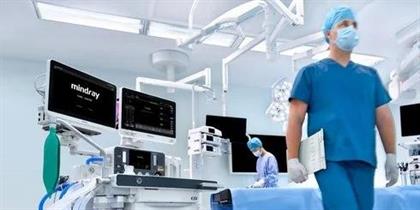
Global vascular access devices market is projected to witness a CAGR of 5.83% during the forecast period 2024–2031, growing from USD 3.63 billion in 2023 to USD 5.71 billion in 2031. With increasing disease burden, rising hospitalization, and an improved healthcare system, the market of vascular access devices is anticipated to expand at a notable pace during the forecast period.
Vascular access devices are insertions used to administer drugs, fluids, blood, and nutrients in blood vessels. These devices include peripherally inserted central catheters (PICCs), central venous catheters, implantable ports, and peripheral intravenous catheters (PIVCs). With the never-ending evolution of healthcare services and medical devices, vascular access devices have evolved in terms of design, material, and integration of imaging technologies in it. Advancements in vascular access devices have improved biocompatibility, flexibility, and the adoption of novel materials, enhancing patient outcomes and quality of life. The rising demand for vascular access devices is driven by the growing burden of lifestyle diseases, technological advancements, and the need for minimally invasive procedures. Manufacturers are consistently working to enhance device design and materials to improve patient outcomes and reduce complications.
For instance, in May 2024, Teleflex Incorporated launched the Arrow EZ-IO Intraosseous Access Procedure Tray, enhancing its intraosseous vascular access portfolio. It includes all necessary components for intraosseous access, featuring the first FDA-cleared battery-powered driver that can be utilized in sterile environments. The tray is designed for quick and precise insertion, addressing the challenges clinicians face in obtaining vascular access during emergencies. However, risks associated with long-term use of catheters, such as infections and sepsis may pose challenges for market growth.
Click here: https://www.marketsandata.com/industry-reports/vascular-access-devices-market
Rising Burden of Chronic Diseases to Increase the Market Size
The chronic disease burden is on a rise globally, owing to the increasing prevalence of chronic diseases, such as cancer, cardiovascular and urological disorders, and others, which necessitates frequent and long-term vascular access for treatments such as chemotherapy, dialysis, and medication administration, thereby driving the demand for various types of vascular access devices, including central venous catheters and peripheral IV catheters. Another factor contributing to the growing burden is the rising geriatric population, highly prone to catching such diseases. With the ongoing scenario, the future demand for vascular access devices is anticipated to increase further.
For instance, the National Institute of Health (NIH), anticipates that the number of adults 50 years and older suffer from at least one chronic disease, which will increase by 99.5% from 71.522 million in 2020 to 142.66 million in 2050. An estimated 48 million people, or 47% of all deaths globally, are expected to die from severe health-related suffering by 2060, an 87% increase from 26 million in 2016. It is anticipated that 83% of these deaths will occur in low and middle-income countries. As per World Health Organization (WHO) estimates, by 2050, there will be twice as many people 60 years or older on the planet with the population of 2.1 billion.
Design Improvements to Drive Market Demand
The established types of vascular access devices include central venous catheters (CVCs), arteriovenous fistulas (AVFs), and arteriovenous grafts (AVGs). Innovations in CVC tip and coating design have improved patency and blood flow rates. AVFs are preferred over CVCs as they are less prone to clotting and infection while providing reliable and adequate blood flow rates. With such design enhancements, the AVF creation devices have significant traction leading to market growth. Market players are taking chances to launch innovative products with enhanced designs. For instance, in September 2023, Laminate Medical Technologies announced that it received US-FDA clearance for its VasQ External Vascular Support device, designed to create AVFs for dialysis access. Notably, 80% of patients in trials using VasQ were able to remove central venous catheters within their first year of treatment, reducing the risk of infection compared to traditional AVFs. The VasQ device provides structural reinforcement to the vessels during AVF creation, promoting better arterial flow and functionality.
Drug Administration Application to Dominate Vascular Access Devices Market Share
The drug administration application of the vascular access devices market is anticipated to cover the highest market share. As these devices provide reliable, long-term access to the bloodstream, which is essential for patients needing frequent or prolonged intravenous therapies, such as chemotherapy or chronic disease management, reducing complications associated with traditional IV lines, such as infections and vein irritation, by minimizing the need for repeated needle sticks. A recent study published in the British Medical Journal in July 2024 examined the effectiveness of vascular access devices (VADs) in reducing infection rates among hospitalized patients. The study concluded that VADs along with specific safety measures reduce the chances of infection.
North America Dominates the Global Vascular Access Devices Market Share
North America is anticipated to hold major market share of the global vascular access devices market. North America’s leadership in the demand for vascular access devices is attributed to its advanced healthcare infrastructure, rising prevalence of chronic diseases, technological innovations, supportive regulations, and demographic trends favoring increased healthcare needs. According to the United States Renal Data System 2023 Annual Data Report, published in April 2024, more than 85% of individuals who began hemodialysis used a catheter. Additionally, nearly three-quarters of the United States population started without permanent access, a significant increase from about 65% in 2018. This rise in number clearly shows an increasing consumption of such devices in North America causing it to hold the largest market share among other regions.
Future Market Scenario (2024–2031F)
The vascular access devices market has witnessed several remarkable futuristic advancements that are anticipated to shape the future of such devices. These advancements include wearable technology, remote monitoring of atrioventricular flow, use of biocompatible materials for product design, 3D printing technology, image-guided vascular access devices, and others. The USFDA approval of WavelinQ and Ellipsys, two vascular access devices that facilitate the creation of arteriovenous fistulas (AVFs) using minimally invasive techniques has paved a new path for more products in line with endovascular fistula creation. The of the most revolutionary advancement is the image-guided vascular access system, Ultreon 1.0 launched by Abbott in October 2023. This platform uses near-infrared light to provide high-definition, precise imaging from within the blood vessels, allowing the healthcare professional precise access to blood vessels even in the most complex anatomies.
Report Scope
“Vascular Access Devices Market Assessment, Opportunities and Forecast, 2017–2031F”, is a comprehensive report by Markets and Data, providing in-depth analysis and qualitative and quantitative assessment of the current state of global vascular access devices market, industry dynamics, and challenges. The report includes market size, segmental shares, growth trends, opportunities, and forecast between 2024 and 2031. Additionally, the report profiles the leading players in the industry, mentioning their respective market share, business models, competitive intelligence, etc.
Contact
Mr. Vivek Gupta
5741 Cleveland street,
Suite 120, VA beach, VA, USA 23462
Tel: +1 (757) 343–3258
Email: info@marketsandata.com
Website: https://www.marketsandata.com
Leave a Reply
Related Products
You Might Like Also

Global Washing Machine Market Size, Share & Forecast 2031
Global washing machine market is projected to witness a CAGR of 4.95% during the forecast period 2024–2031, growing from USD 57.65 billion in 2023 to USD 84.85 billion in 2031. Read More

Global Anesthesia Equipment Market Size, Share, Growth Report 2031
Global anesthesia equipment market is projected to witness a CAGR of 7.67% during the forecast period 2024–2031, Read More

The Saudi Arabia Cloud Computing Market has experienced significant progress and is expected to observe substantial growth in the estimated future. Read More

Global eClinical solutions market is projected to witness a CAGR of 13.11% during the forecast period 2024–2031, growing from USD 10.01 billion in 2023 to USD 26.81 billion in 2031. The market is expected to grow in the forecast period due to several underlying factors. Read More











